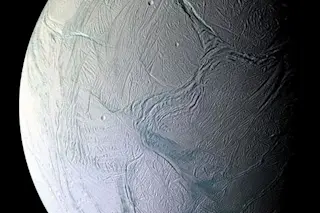A time-lapse movie uses images taken from Jan. 6 to Feb. 3 1979 by the Voyager 1 spacecraft as it was heading toward it's closest approach to the planet on March 5, 19979. (Source: NASA Planetary Photojournal) It has been 37 years since the Voyager 1 spacecraft began sending back glorious, up-close imagery of Jupiter and its coterie of moons. And today, March 5th, marks the actual anniversary of the spacecraft's closest approach to the giant gaseous planet. So I thought I'd share this animation of images taken by the spacecraft as it was making its final approach to Jupiter. It's known as the Voyager "Blue Movie," because it was built from images acquired through a blue filter. The sequence consists of 66 images taken each time Jupiter rotated once on its axis. (Each of these Jovian days lasted about 10 hours.) At the start of the approach documented in the animation, on Jan. 6, 1979, the spacecraft was 36 million miles from Jupiter. At the end of the animation it was 19 million miles away, on Feb. 3. A little over a month later, Voyager 1 came within 128,400 miles of Jupiter during its closest approach. It finally left the Jovian system in early April, having taken almost 19,000 images.

Voyager 1 captured this image of the plume from an enormous volcanic eruption on Io on March 4, 1979, about 11 hours before it made its closest approach to this moon of Jupiter. (Source: NASA Planetary Photojournal) Here's one of the more memorable ones: a portrait of Io, one of Jupiter's moons, just as an incredibly violent volcanic eruption was spewing material 100 miles high — with an ejection velocity calculated at 1,200 miles per hour. NASA describes this volcanism as "one of the most surprising discoveries of the Voyager 1 mission." The plume is that greenish feature erupting against the blackness of space, toward the upper left. (NASA used digital processing to boost its brightness, otherwise it would have been very faint.) The photograph was made from a distance of about 304,000 miles as Voyager 1 was approaching. After its Jovian tour, Voyager 1 flew on to Saturn, arriving there on Nov. 12, 1980. It flew close to Titan, a large moon, and behind Saturn's rings. Ultimately, this trajectory bent the spacecraft's path northward out of the plane in which most of our solar system's planets orbit the Sun. https://youtu.be/LIAZWb9_si4 Voyager 1 became the first manmade object to make it into interstellar space, probably on Aug. 25, 2012, according to NASA. You can hear what that sounded like to the spacecraft by checking out the video above. On Feb. 27, 2016, it was about 12.5 billion miles from the Sun, and speeding ever outward.














